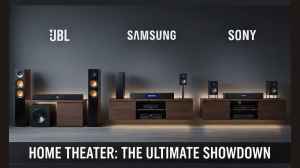The search for the perfect home theater system often leads to three titans of audio technology: JBL, Samsung, and Sony. Each brand brings a unique philosophy to sound design, making the choice incredibly challenging. JBL, with its heritage in professional audio, is often associated with raw power and deep, impactful bass, aiming for a fun, dynamic movie experience. Samsung focuses on smart integration, sleek aesthetics, and immersive virtual surround technology to create a comprehensive, modern entertainment hub. Finally, Sony, with its long-standing expertise in Hi-Fi audio and cinematic sound, typically leans towards clarity, balance, and advanced proprietary sound processing to deliver a refined and detailed soundstage. This article dives deep into six popular 2.1 and 5.1 channel soundbar systems from these brands, and find out which audio giant truly takes the lead in delivering the best home system theater system for your space?
The Battle for Sound Quality: JBL vs Samsung vs Sony
When the lights go down and the movie starts, sound quality is paramount. These three brands approach cinematic audio with distinct signatures:
- JBL: The core focus is on creating a punchy, high-impact sound ideal for action movies and bass-heavy music. Dialogue clarity is maintained, but the overall experience is characterised by its sheer volume and low-end rumble. JBL excels for those who prioritise a fun, powerful, and energetic sound.
- Samsung:. Their strength lies in seamlessly integrating with Samsung TVs (via features like Q-Symphony, on high-end models) and optimising sound dynamically based on the content. The sound profile is generally brighter and clearer, making dialogue exceptionally crisp. Samsung is the best fit for those who want a modern, integrated system with smart, balanced audio and clear voices.
- Sony: Sony leverages technologies like S-Force PRO Front Surround and their X-Balanced Speaker Unit to produce a sound that is meticulously detailed and balanced across the entire frequency range. While the bass is deep, it is typically tighter and more controlled than JBL's, aimed at cinematic accuracy rather than brute force.
Performance and Features: Channel Configuration and Connectivity
- JBL soundbars generally offer a clean, powerful setup, but their virtual surround (like MultiBeam) works best after calibration. Their connectivity is robust, often including Wi-Fi (for streaming) and dedicated HDMI inputs, appealing to tech-savvy users who want a versatile, high-powered media centre.The system power output tends to be very high, ensuring room-filling audio without distortion.
- Samsung leads in seamless integration and user-friendly features.Their systems are often part of a larger ecosystem, with 'One Remote Control' functionality simplifying daily use. Features like Game Mode and Adaptive Sound make them highly versatile for different types of content.
- Sony offers a blend of performance and simplicity. Systems like the HT-S20R provide true 5.1 surround sound with wired rear speakers, which, while requiring cables, guarantee superior directional audio placement over virtual solutions.
Affordability and Value: Finding the Best Investment
Evaluating the long-term value involves looking at the price-to-performance ratio and included features.
- The Sony HT-S20R (5.1ch) is often one of the most competitively priced true 5.1 systems on the market, giving you physical rear speakers for a budget-friendly price.
- Samsung's systems are often priced competitively in the mid-range, the value proposition here is in the integration and the ability to expand later with wireless rear speaker kits (sold separately), making them a flexible long-term investment.
- JBL products often command a slightly higher price point, which is justified by their superior build quality, high-power output (550W+ for high-end models), and signature deep bass from large subwoofers.
For a better understanding, let's have a look at the top 2.1 and 5.1 ch models from these home theatre brands, focusing on its features and functionality.



